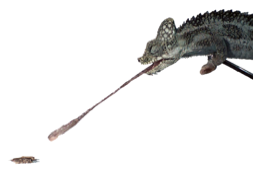Thermal Effects on High-Powered Ballistic Movements
Chameleons, toads and some salamanders feed by way of ballistically projecting their tongue from their mouth to capture prey. These highly specialized feeding mechanisms utilize elastic storage mechanisms, similar in ways to a bow-and-arrow, to launch the tongue. This recoil of elastic elements allows for extreme performance outputs far exceeding that of known muscle properties. My dissertation research under Dr. Stephen Deban focused on the thermal effects of feeding in chameleons (family Chamaeleonidae) in order to understand how explosively dynamic movements powered by elastic recoil are effected by temperature. We discovered that in addition to producing extreme performance, this elastic recoil also liberates tongue projection from much of the normal decrease in performance associated with muscle-powered movements at low temperatures, allowing them to feed at high performance, even at low temperatures where other sympatric lizard species remain inactive.
The first portion of this study was published in the Proceedings of the National Academy of Sciences and was the subject of a range of press coverage. Additionally, further studies examining the mechanistic basis for this interaction in chameleons, including muscle activity patterns and muscle contractile dynamics, was published in the Journal of Experimental Biology.
This video from our PNAS paper shows two feedings by a single Chamaeleo calyptratus at 15ºC (lower) and 35ºC (upper) showing similar projection performance yet different retraction performance.
Further research on this topic in the Deban Lab has since examined this interaction in other taxa and found similar results. This included work with Dr. Deban, and Nicholas Larghi looking at this interaction in a plethodontid salamander (Eurycea guttolineata), the results of which were published in the Journal of Experimental Biology.
Most recently, I have examined how this interaction effects patterns of thermal specialization across species living along an environmental temperature gradient. Previous research has shown that both adaptation and acclimation to low muscle temperature in species from cold environments are known to mitigate thermal effects in muscle-powered movements at low temperature. However, because low thermal dependence results in a wider thermal performance breadth, natural selection might act differently on movement types that benefit from lower thermal dependence (i.e. elastic recoil powered movements) than it would on movement types that experience higher thermal dependence (i.e. muscle-powered movements). This study tested this idea in South African dwarf chameleons (genus Bradypodion) in collaboration with Dr. Krystal Tolley from the South African National Biodiversity Institute in Cape town and the manuscript for this study is currently being revised for publication.
Funding Acknowledgements:
National Science Foundation Grant No. IOS 0842626 (to SMD)
The Journal of Experimental Biology Traveling Fellowship (to CVA)
Sigma Xi Grants-in-Aid of Research (to CVA)
RocketHub Crowdfunding Donators including from Chameleon Forums, Reptile Super-Show, Allison Banks, Heather Hallen-Adams, Jeff Bass, Mike Birdsall, Rob Clark, Jay Sommers, ChamEO Inc., Chelsea Anderson, Jann Besok, Tracey Cress, Alex Fradl, Heidi Rockey, Laurie Sageser, Ellen Smock, Andrew Venable, Dave Weldon, Thomas Althaus, Mischa Andrews, Morgan Fultz, Lindsay and Nate Goddard, Michael Kern, Mary Lovein, Alisa Poppen, Jeremy A. Rich, Jeffrey Routh, Ryan Garza, and Nicholas Larghi (to CVA)
University of South Florida Fred L. and Helen M. Tharp Endowed Scholarship (to CVA)

Thermal Effects in Ballistic Movements
Bradypodion thamnobates
© 2009 Christopher V. Anderson
